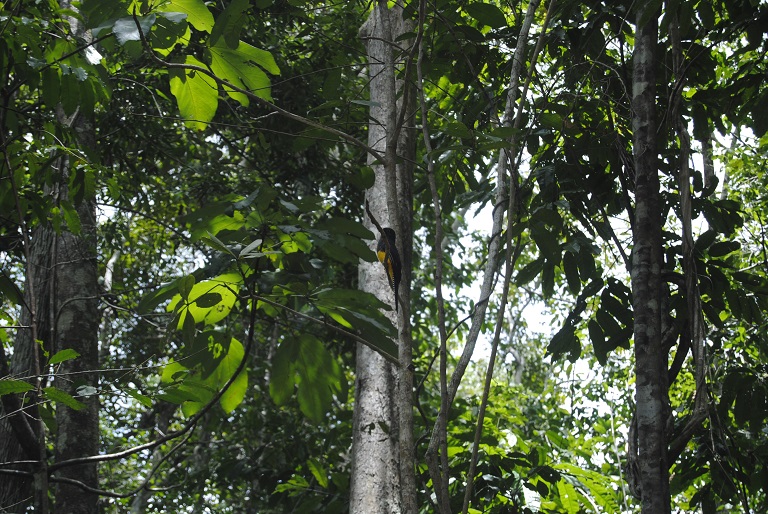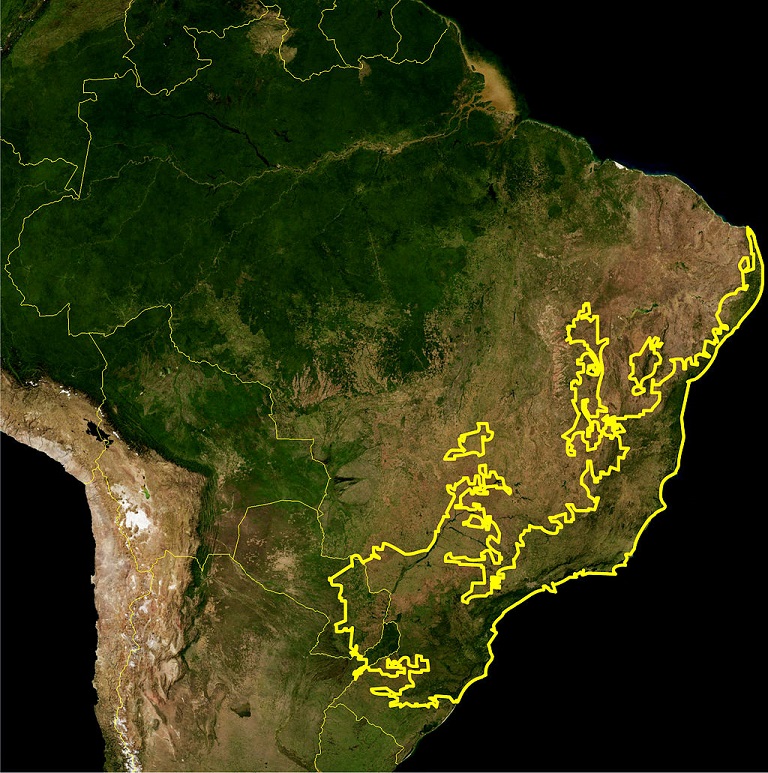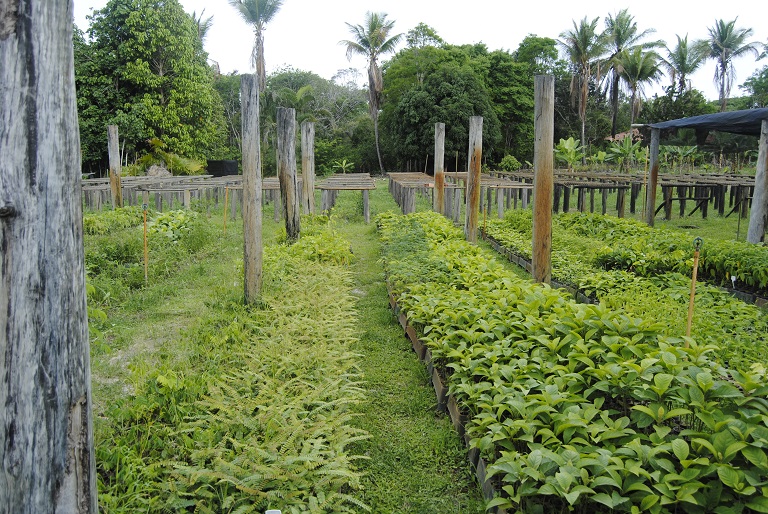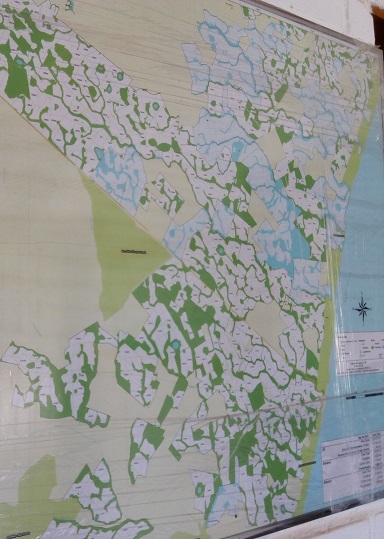- Since 2001, Brazil has almost doubled its area of protected land without increasing its conservation budget.
- In the central corridor of the Atlantic Forest, protected areas are scattered among large extensions of eucalyptus monocultures maintained by pulp companies.
- With limited resources and facing powerful companies, those in charge of protected areas are stuck between a rock and a hard place.
CORREGO GRANDE, Brazil – The Brazilian Atlantic Forest is the most threatened biome in Brazil and has been subjected to the harsh consequences of human development. But despite having lost more than 85 percent of its original extension, according to the Brazilian non-profit SOS Mata Atlântica Foundation, it is still a global hotspot for biodiversity and home to many unique species.
Yet desertification continues to plague the central corridor of the Atlantic Forest, spanning Brazil’s southeastern states of Espírito Santo and Bahia. Representing an area larger than the state of Delaware, the Brazilian Institute of Geography and Statistics (IBGE) figures show that these two states play host to more than 880,000 hectares of eucalyptus. To the south, the government has handed over management of 25 Atlantic Forest state parks to private companies.
The Brazilian Ministry of Environment has long acknowledged that one of the main causes of desertification in the area has been the replacement of native forests with eucalyptus monocultures to feed the pulp industry. Among these large fields of eucalyptus, a few remnants of Atlantic Forest struggle to survive, many in the form of nature reserves.
Myriad issues pose serious threats to these last survivors, including low funding, red tape and the expansion of the pulp industry.
One of the natural reserves in the eucalyptus region of the Atlantic Forest’s central corridor is the Reserva Biológica do Côrrego Grande, owned by the federal government and located on the Espírito Santo side of the border with Bahia. With 1,500 hectares (over 3,700 acres) of well-conserved Atlantic Forest, the reserve is home to many endemic plants and animals, including some rare hummingbirds. It is classified by Brazilian law as an area under “full protection” and visits are only allowed for research or educational purposes in order to minimize human impact.
“There are probably species here that haven’t been described yet,” said Gabriel Rezende, manager of the reserve. “This is their last refuge.”

Côrrego Grande has a triangular shape and is enclosed by eucalyptus fields on its north- and east-facing sides. On the north side, a gravel road runs parallel to the reserve and marks the boundary between the states of Espírito Santo and Bahia. During the day, dozens of timber trucks rumble past, raising clouds of dust that fall on the reserve. As a consequence, the trees by the road are warped and twisted.
The west side of the reserve currently faces a pasture, but that could change soon.
“A company [Suzano] has applied for a license to grow more than 4,000 hectares [almost 10,000 acres] of eucalyptus here. If the license is issued, we’ll be completely surrounded by eucalyptus,” Rezende said. It would also lead to an increase in the number of trucks traversing the gravel road, the only access to the area.
A spokesperson for Suzano, who asked to only be identified by their position, explained by e-mail that licenses are issued by local authorities, and said any license is conditional on mitigation and compensatory actions.
Regardless of the outcome, the reserve is already facing difficulties.

The security contract recently expired and hasn’t been renewed due to payment delays, leaving the reserve unwatched. Also, despite drought that affects the region, the government has cut the number of fire brigades by half, according to the national newspaper O Globo. In Côrrego Grande, where there use to be a squad formed by seven people, there are now only two firefighters.
Not far from Côrrego Grande is the Floresta Nacional do Rio Preto, a larger reserve of 2,830 hectares (about 7,000 acres), also owned by the federal government and managed by Alberto Klotz and Murilo Machado. They also suffer from a lack of vigilance and cuts on fire brigades.
“Every day I wake up fearing that someone might have stolen our chainsaws,” Machado said. Without their tools, they can’t work, and acquiring new ones would involve months of bureaucracy, yet they continue to put on a brave face.
Machado and Klotz recently created a nursery with Atlantic Forest seedlings to sell to local landowners, as the law obliges all rural properties to maintain native trees in 20 percent of their area. Last November, they organized an environmental education activity with schools, which included a trail decorated with life-sized reconstructions of some of the animals that live in the reserve. Interspersed with the reconstructions, colorful live birds, illegally captured by poachers and later seized in raids, were also displayed.
Even those efforts are a strain, though.
“To work in the nursery, the environmental education activities, the raids and the maintenance of the park, we would need around 12 people,” Machado said. “Instead, we’re just two.”
Money that grows on trees
Alongside the challenges faced by the reserves, pulp companies thrive with their eucalyptus monocultures. A recent article about the Brazilian pulp industry in The Economist summed up the situation neatly with the headline: “Money that grows on trees.”
Fibria, the world’s largest producer of eucalyptus-derived pulp, had record revenues of $3.1 billion in 2015, according to the company. These revenues include 50 percent of those of Veracel, a joint venture between Fibria and the Scandinavian company Stora Enso. The second largest Brazilian company, Suzano, also had a good year with a net revenue of $3.2 billion according to the company.
The Suzano spokesperson explained, however, that profits can be fickle.
“As many companies in the commodity sector we are subject to the commodity price and exchange rates fluctuation,” the spokesperson said. “So in 2015 the company had a good result, which is completely opposite from 2016, where both price and exchange rate [were] unstable.”

Pulp companies do market themselves as green and collaborate with the reserves in different ways.
For example, Rezende recently reached an agreement with Suzano to have someone working in Côrrego Grande on their payroll. Suzano funded the environmental education project for students.
“As a land-based company, we believe our actions must go beyond our farm fences,” the spokesman from Suzano said. Fibria has funded similar programs in the past. Fibria declined to comment.
While Rezende welcomes these initiatives, he also sees drawbacks.
“The help comes under the companies’ terms and can go away as swiftly as it comes,” he said.
Also, the help can put the reserves in an uncomfortable situation when there is a conflict of interests.
“One of the companies [Suzano] is about to renew the license on more than 22,000 hectares [over 54,000 acres] of eucalyptus in the area around Côrrego Grande and Rio Preto,” Rezende said. “However, they are processing it as many small properties instead of just one big undertaking to avoid paying any ‘environmental compensation‘.” Rezende is referring to the money that companies have to pay to protected areas whenever they engage in initiatives with high environmental impact.
“The majority of areas licensed recently are formed by large farm blocks,” Suzano’s spokesperson explained, not referring specifically to the area mentioned by Rezende. “All compensations related to these farm blocks have being paid accordingly to the Brazilian Law.”
Claims of protection
In addition to partnering with the reserves, the companies also claim to protect the Atlantic Forest by keeping part of their land with native forests.

Fibria, for example, owns three private natural reserves in Espírito Santo: one of 2,212 hectares (5465 acres) and two smaller ones of 296 and 379 hectares (731 and 936 acres). Veracel owns a large reserve of 6,096 hectares (over 15,000 acres) in Bahia.
However, most of the land that the companies set aside for conservation is preserved to comply with existing regulations. In some cases, specific areas are protected for ecological reasons, such as having water streams. In others, the law demands that 20 percent of all rural properties should be maintained with native trees.
Brazil has more than 463,000 square miles of protected areas, an increase of 83.5 percent between 2001-2011 according to the Brazilian Ministry of Environment, but public funding devoted to conservation has not increased proportionally. The government budget allocated to conservation units has not increased since 2001 sitting at circa $88 million per year. Consequently, the economic resources per protected area plunged 40 percent between 2001 and 2010.
Brazil spends only $1.3 per protected hectare, well below other countries such as the U.S. ($45.5), Canada ($15.5) or Argentina ($6.2). Low funding has led to a very limited number of staff: there are 18,600 protected hectares per worker in Brazil, compared to 2,125 in the US, 2,400 in Argentina and 5,257 in Canada.
The overall situation is about to get even more challenging: earlier this month, Brazil’s environment ministry budget was cut by more than 50 percent.
Red tape also complicates the use of resources. In 2009, for example, the Ministry of Environment acknowledged that it was only able to spend half of its budget. Also, the law requires that every purchase is made through a previous bidding, causing long delays and, ironically, higher prices.
The companies argue that they do more than the law requires them to do.
“Our current conservation area is 477,490 hectares [almost 1.2 million acres] or 40 percent of our total area nationwide,” writes the spokesperson from Suzano. “This is the double of the 20 percent threshold and also above the benchmarking of protected areas for forest companies globally.”
Although these areas account for a large extension when added together, they are highly fragmented, limiting their biodiversity. The jaguar (Panthera onca), for example, which is classified by the IUCN in the Atlantic Forest as with “low probability for survival,” requires an average territory size of about 2,500 hectares, about the same size of the whole Rio Preto reserve. So it’s not only a matter of how much land is protected, but also of how well connected it is: the more fragmented the forest is, the more threatened it becomes.
Banner image: A yellow-fronted woodpecker (Melanerpes flavifrons) in Brazil’s Atlantic Forest. Photo by Germano Woehl Junior for the Instituto Rã-bugio para Conservação da Biodiversidade.
Ignacio Amigo is a freelance journalist based in São Paulo, Brazil. You can find him on Twitter at @IgnacioAmigoH.
FEEDBACK: Use this form to send a message to the author of this post. If you want to post a public comment, you can do that at the bottom of the page.

